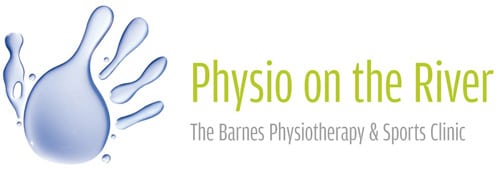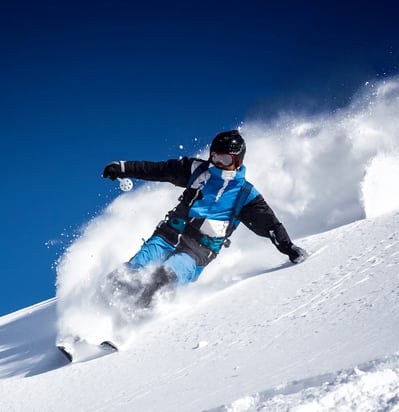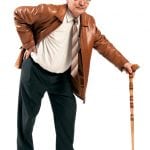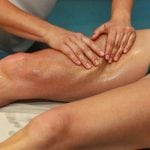How Physio helps recovery from Anterior Cruciate Ligament skiing injury
With the Easter holidays underway, it’s that time of year again for skiing fun!
Hopefully you will have done your pre-skiing preparation but unfortunately, even with the best laid plans, injuries can still occur.
Katherine Ashmore is one of our team of Physiotherapists and a keen skier herself. In this blog she runs through the common mechanisms of ACL injury, how the diagnosis is made, the options for treatment and how Physio is vital to recovery whether you choose surgery or not.
Common mechanisms of injury
Common down-hill skiing injuries to the knees occur when landing from a jump or going over moguls, colliding with another skier as you exit the ski lift, or simply falling and twisting your knee.
We also see upper limb injuries when falling onto the outstretched hand or landing heavily onto the shoulder. The injuries are often brought on by one too many at lunchtime, bad snow, tiredness at the end of a day or when bindings do not release!
The most prevalent types of injury are bone fractures, joint dislocations or soft tissue injuries such as ligament strains, tears and ruptures. The knee is the most common area to injure and more specifically – injuries to the ACL (anterior cruciate ligament), MCL (medial collateral ligament) and medial meniscus (inner cartilage) tears being top of the list! A combination of all three is called ‘The Unhappy Triad’.
Focusing on the Anterior Cruciate Ligament
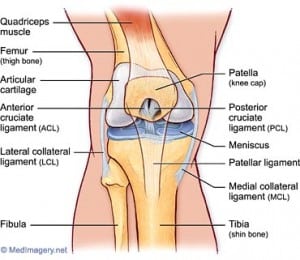
sourced from www.sportsmedicineeuk.co.uk
The anterior cruciate ligament (ACL) is located deep inside the knee joint and attaches the thigh bone (femur) to the main shin bone (tibia). It keeps the knee stable by preventing the forward motion of the shin from going too far and the knee from rotating too much.
The vast majority of ACL injuries happen during slow-speed turns, often in sticky, slushy snow, towards the end of the day when the skier is distracted and tired. The ski goes one way and the skier’s body weight goes the other causing rotation of the knee. Because of the slow speed the bindings don’t release.
This tends to happen to beginners, but can also happen to experts who have their bindings very tight and get momentarily distracted in the conditions described above. At higher speeds, the bindings release and the injury is less likely; hence, the advice is to ski positively and ensure that the ski bindings set properly.
How do I know it’s an ACL injury?
With severe injury, one hears a loud pop or feels a snapping sensation, followed by intense pain and immediate swelling and difficulty walking. Diagnosis is confirmed by a specialist (Physiotherapist or Orthopaedic Consultant) and MRI. An arthroscopy can detect a partial tear. Much less usually very experienced skiers can carry on skiing after injury.
How can Physiotherapy help?

sourced from milfordphysio.co.nz
Once you have your diagnosis there are two routes – surgery versus non-surgery.
A surgeon will weigh up the factors with you: your age, lifestyle and sports interests and whether you wish to go through the surgical route. The knee can be very strong and able without requiring a functioning ACL and these options will be discussed with you, including any associated risk of further injury or limitations in exercise or mobility.
Whether or not you opt for surgery, Physiotherapy is vital to strengthen the knee and get you back to full fitness. Without Physio the knee can remain weak and more susceptible to recurrent injury.
What is prehab?
Often if surgery is required, the surgeon will wait for the swelling to go down first. This is a great opportunity to receive ‘prehab’. Our Physios will help you to strengthen your knee muscles prior to surgery and get you physically and mentally prepared for your operation. Having knowledge of the exercises you will need to do post surgery is a great help and we find our clients do better with this preparation.
Post op rehab
Where the prognosis indicates surgery, the surgeon will discuss with you whether you use one of your own tendons (commonly a bit of the hamstring) to repair the ACL or use a synthetic option. It is a very common procedure and depending on your level of exercise will take 8-12 months of graded physiotherapy rehabilitation to get back to full sport. You may even be back to skiing within the year!
What does rehab involve?
Treatment will involve:
- a carefully graded exercise programme
- advice on swelling reduction measures
- graded return to exercise (we can tell you what exercise, how much and at what stage) and
- latterly sports specific exercise drills if required
Some surgeons have very specific protocols they like us to follow and others are not so prescriptive. but either way we have the expertise and experience to guide you through the process.
We work closely with Orthopaedic Consultants locally and in central London clinics and can fast track you to be seen quickly with one of them if necessary.
Should you receive a skiing injury we are here to help you with both diagnosis and treatment.
Please don’t hesitate to book an appointment with our Physiotherapist, Katherine Ashmore, or another member of our Physio team.
To book an appointment:
Call 020 8876 5690
Book an appointment online
Email us here
Or just drop in for a chat with one of our Physios!
If you have enjoyed this blog and would like to read our other skiing blogs click here.
